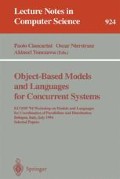Abstract
We discuss “Bauhaus Linda” (or Bauhaus for short), a Lindaderived coordination language that is in many ways simultaneously more powerful and simpler than Linda. Bauhaus unifies tuples and tuple spaces, leading to an especially clean treatment of multiple tuple spaces, and treats processes as atomic and explicitly represent able. We present an informal semantics of Bauhaus and discuss an extended example that demonstrates its expressivity and simplicity.
Research partially supported by grants AFOSR-91-0098 and ONR-N00014-93-1-0573
Preview
Unable to display preview. Download preview PDF.
References
N. Carriero, E. Freeman, and D. Gelernter. The lifestreams software architecture. Technical Report TR1054, Yale University, Department of Computer Science, 1994. In preparation.
N. Carriero and D. Gelernter. Coordination languages and their significance. Commun. ACM, 35(2):97–107, Feb. 1992.
N. Carriero, D. Gelernter, and L. Zuck. Bauhaus Linda: An Overview. In G. Hommel, editor, Proceedings of the International Workshop on the Quality of Communication-based Systems, Dordrecht, The Netherlands, 1994. Kluwer Academic Publishers.
N. Carriero, D. Gelernter, and L. Zuck. Capabilities in Bauhaus. Research report, Yale University Department of Computer Science, 1994. In preparation.
K. M. Chandy and L. Lamport. Distributed snapshots: Determining global states of distributed systems. ACM Trans. Comput. Syst., 3(1):63–75, 1985.
D. H. Gelernter. Mirror Worlds. Oxford, New York, 1991.
W. Hasselbring. On integrating generative communication into the prototyping language PROSET. Informatik-Bericht 05-91, UniversitÄt Essen, Dec. 1991.
S. Jagannathan. TS/Scheme: Distributed Data Structures in Lisp. In 2nd Workshop on Parallel Lisp: Languages, Applications and Systems, Oct. 1992. Also published as: NEC Research Institute Tech Report: 93-042-3-0050-1.
F. Mattern. Virtual time and global states of distributed systems. In M. Cosnard, editor, Proceedings of the International Workshop on Parallel and Distributed Algorithms, pages 215–226. North-Holland, 1989.
C. Morgan. Global and logical time in distributed algorithms. Information Processing Letters, 20:189–194, 1985.
Scientific Computing Associates, New Haven, CT. Paradise: User's Guide and Reference Manual, 1994.
Author information
Authors and Affiliations
Editor information
Rights and permissions
Copyright information
© 1995 Springer-Verlag Berlin Heidelberg
About this paper
Cite this paper
Carriero, N., Gelernter, D., Zuck, L. (1995). Bauhaus Linda. In: Ciancarini, P., Nierstrasz, O., Yonezawa, A. (eds) Object-Based Models and Languages for Concurrent Systems. ECOOP 1994. Lecture Notes in Computer Science, vol 924. Springer, Berlin, Heidelberg. https://doi.org/10.1007/3-540-59450-7_5
Download citation
DOI: https://doi.org/10.1007/3-540-59450-7_5
Published:
Publisher Name: Springer, Berlin, Heidelberg
Print ISBN: 978-3-540-59450-5
Online ISBN: 978-3-540-49269-6
eBook Packages: Springer Book Archive

